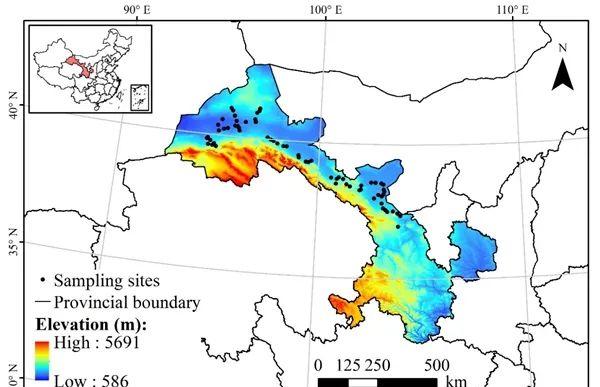In recent years, studies have shown that different microbial groups, especially bacteria and fungi, exhibit different latitude, longitudinal and altitude diversity distribution patterns on a global scale, while research on the biogeographic patterns of desert ecosystems needs to be improved.
Li Yuqiang's team at the Northwest Institute of Eco-Environment and Resources, Chinese Academy of Sciences, is committed to the study of the driving mechanism of resource and environmental elements on ecosystem evolution in arid and semi-arid regions. The scientific research team collected surface soil (0-20 cm) from 75 samples in the east-west range of the desert area of the Hexi Corridor (Figure 1), based on the second-generation high-throughput sequencing platform (Illumina MiSeq PE300 Platform), combined with regional climatic characteristics and soil physicochemical properties, and preliminarily determined the diversity distribution pattern of soil bacteria, archaea and eukaryotes in the desert area of the Hexi Corridor. The results showed that soil bacterial and eukaryotic biodiversity in the desert area of the Hexi Corridor increased linearly with the increase of longitude and elevation, and decreased with the increase of latitude, while the diversity of archaea did not change much in the geographical gradient (Figure 2). In bacteria, archaea, and eukaryotic communities, the α-diversity of some phyla is inconsistent with the overall trend, such as the α-diversity of 6 of the top 10 bacterial phylums with relative abundance increased significantly with elevation. Based on the distance-decay model and community similarity and euclidean distance analysis, geographical distance and environmental factors have an effect on the composition of soil microbial communities in the desert area of the Hexi Corridor, and the influence of geographical distance on soil microbial community composition is slightly stronger than that of environmental variables (Figure 3). Based on The Partial Mantel test and the comprehensive analysis of variance decomposition (VPA), it was determined that soil factors (pH, TC, TN and TC/TN) were the most important environmental factors driving the composition of soil microbial communities in the region. However, geographic distance and environmental variables have limited interpretation of soil microbial community composition, especially for archaea and eukaryotic communities, which may imply that certain unknown environmental factors play an important role in driving soil microbial community formation. Based on the analysis of symbiotic networks, it is found that the connections within the soil microbial network domain in the desert area of the Hexi Corridor are stronger than those between the domains, and most of them are positive connections (Figure 4). Although bacteria form more connections than archaea and eukaryotes, removal of archaea results in a significant reduction in natural connectivity, suggesting that archaea may be the core taxon that constructs the soil microbial symbiosis network in this desert area (Figure 5).
This study reveals the distribution pattern of soil microbial communities and their driving factors in the desert area of the Hexi Corridor, deepens people's understanding of the pattern of soil microbial diversity in the region, and provides scientific support for the sustainable management of desert ecosystems.
The research results are published online in Catena under the title of Biogeographic patterns of soil microbe communities in the deserts of the Hexi Corridor, northern China. The research work was supported by the Second Comprehensive Scientific Expedition to the Tibetan Plateau, the National Key Research and Development Program and the National Natural Science Foundation of China.

Figure 1: Geographical location and sampling site of desert area in Hexi Corridor
Figure 2:Linear regression analysis of species richness and diversity patterns along the geographical gradient of bacteria, archaea and eukaryotic communities
Figure 3.Variation allocation analysis of bacterial, archaea and eukaryotic communities by geographic distance, climatic factors (MAT and MAP) and soil variables (pH, TC, TN, TC/TN ratio, and EC) and their interactions
Figure 4.Colinear analysis of soil microbial communities in the desert area of Hexi Corridor
Figure 5.Robustness analysis of soil microbiota network in desert area of Hexi Corridor
Source: Northwest Institute of Eco-Environment and Resources, Chinese Academy of Sciences